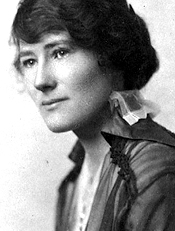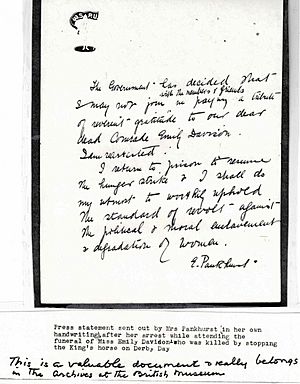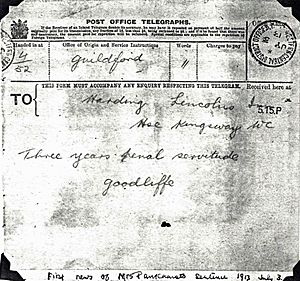Gertrude Harding facts for kids
Quick facts for kids
Gertrude Harding
|
|
|---|---|
 |
|
| Born |
Gertrude Menzies Harding
1889 Welsford, New Brunswick, Canada
|
| Died | 1977 (aged 87–88) New Brunswick, Canada
|
| Nationality | Canadian |
Gertrude Menzies Harding (1889-1977) was a brave woman who fought for women's rights. She was known as a suffragette, which means she worked to get women the right to vote. Gertrude was born on a farm in Canada. In 1912, she moved to London, England. There, she joined a group called the Women's Social and Political Union. This group was very active in fighting for women's voting rights. Gertrude Harding became an important and long-serving member of this movement.
Contents
Early Life in Canada
Gertrude Harding was born in 1889. She was the youngest of seven children. Her family lived on a farm in Welsford, New Brunswick, Canada. Gertrude loved the outdoors. She enjoyed hunting, fishing, and camping by herself in the woods. She even had a pet raccoon that went with her!
When Gertrude was 18, doctors found she had a heart murmur. This was seen as a serious health issue back then. Luckily, she got to travel to Hawaii. She went as a companion for her older sister, Nellie Waterhouse, and her family. In Hawaii, Gertrude taught sewing classes to local women. She also helped care for a boy who had polio. This experience made her want to help people in need.
Fighting for Women's Rights
In 1912, Gertrude joined her sister's family in London, England. Her brother-in-law, Dr. Ernest Waterhouse, had business there. Soon after arriving, Gertrude saw women marching with signs. The signs said things like "Votes for Women." She was very interested in their cause.
Gertrude quickly became a paid organizer for the Women's Social and Political Union. This meant she earned her own money. For the first time, she moved out and lived on her own.
Bold Actions for the Cause
One of Gertrude's first big actions was at the Royal Botanical Gardens in Kew. She and another suffragette, Lilian Lenton, planned a midnight protest. They wanted to damage rare orchids. During the day, they pretended to be tourists to find the best spots. That night, they broke into glasshouses with the orchids. They wanted to cause as much damage as possible before being caught.
Newspapers reported the "outrage" at Kew Gardens the next day. Some even thought only men could have climbed the six-foot wall to escape. Gertrude was later linked to other protest actions, like a fire at the Roehampton croquet pavilion.
Protecting the Leader
Gertrude Harding also worked on The Suffragette newspaper. This happened when the police raided the group's office. The newspaper then had to be produced secretly.
A very important part of Gertrude's work was leading a secret bodyguard group. These women protected their leader, Mrs. Emmeline Pankhurst. The police, called Scotland Yard, kept trying to arrest Mrs. Pankhurst. This was because of a law called the Cat and Mouse Act.
The bodyguard women learned jujitsu from Edith Garrud. They also carried rubber clubs. Even with training, they often got hurt. But they were clever! They used disguises and tricks to outsmart the police. Sometimes, a woman pretending to be Mrs. Pankhurst would get arrested. This allowed the real Mrs. Pankhurst to escape.
In 1914, Gertrude Harding became the editor of The Suffragette newspaper.
During World War I
When World War I started, Gertrude stayed with the WSPU. She remained loyal to the Pankhurst family. They supported the British government during the war. Gertrude was a private secretary to Christabel Pankhurst when Christabel was living in Paris in 1915.
The Suffragette newspaper was renamed Britannia. Gertrude edited this paper for five months. Eventually, the Pankhursts could no longer pay her. Gertrude then found a job at a factory in Scotland. This factory made ammunition for the war. She helped the women who worked there, as conditions were very tough.
Later Years and Legacy
In 1920, Gertrude moved back to Canada. She lived in a small house on a farm in New Brunswick. After a year, she got a job in Plainfield, New Jersey, as a Welfare Supervisor. She worked there for 13 years.
In her middle years, Gertrude volunteered for many groups. She worked for peace, women's rights, animal rights, and to help the poor. She wrote down her life story in a memoir. She put it in a scrapbook with photos and her own drawings. She gave it to her niece, Peggy Harding.
Gertrude kept in touch with her family in New Brunswick. In 1976, she returned there when she became sick with cancer. She lived with her niece, Audrey Starr.
Gertrude Harding passed away a year later, in 1977, at the age of 88. She never married or had children.
In 1996, Peggy's great-niece, Gretchen Kelbaugh, published a book. It was called With All Her Might; the Life of Gertrude Harding, Militant Suffragette. This book included Gertrude's scrapbook.
How Gertrude Harding is Remembered
Gertrude Harding's story has been shared in different ways:
- She is shown in Ann Bertram's play The Good Fight. This play is about another suffragette, Grace Roe.
- Gertrude and her sister Nellie are also in Peter Hilton's play Mrs Garrud's Dojo. This play includes Edith Garrud, who taught the suffragettes jujitsu.
- Gertrude partly inspired a character named Persephone Wright in a graphic novel series. It's called Suffrajitsu: Mrs. Pankhurst's Amazons (2015). She also appears as herself in other stories from that series.
- Scottie Caldwell plays Gertrude Harding in a documentary. It's called No Man Shall Protect Us: The Hidden History of the Suffragette Bodyguards (2018).



